A complete list of dolphin species with pictures and interesting facts. Discover the many different types of dolphins that are alive today.
Dolphins are marine mammals belonging to the infraorder Cetacea, which is also home to whales and porpoises. Known for their high intelligence and acrobatic displays, dolphins are among the most familiar and best-loved members of the animal kingdom.
On this page is a list of all living dolphin species, with pictures and interesting facts on each. The list contains every species in the oceanic dolphin family Delphinidae, and all of the river dolphins, which are found in freshwater habitats.
Also on this page is an interactive table of dolphin species. Using this, you can explore dolphin species by sorting them by name, family, genus, size, conservation status, etc.
Page Index
- List Of Dolphins
- Dolphin Species Table
- How We Complied This List
- Discover More: Related Pages On Active Wild
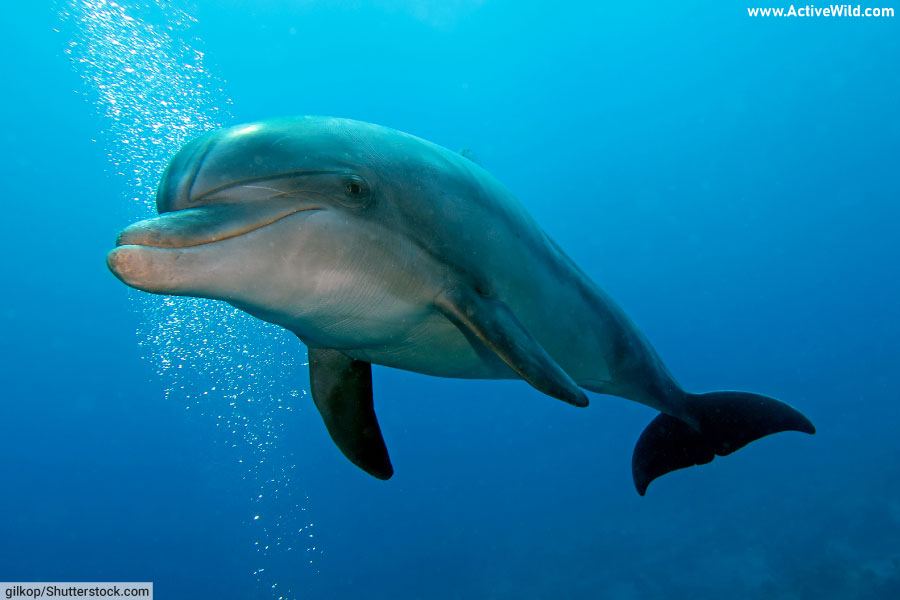
There are 40 living dolphin species*. (On this page, 41 species are listed, as we've included the Baiji, which is now believed to be extinct.)
* We've used the dolphin species listed in the Catalogue of Life online database. Other authorities may recognize a different number of dolphins - see the how we compiled this list section for details.
The list contains dolphins that are commonly known as whales, including the killer whale or orca (which is an oceanic dolphin belonging to the family Delphinidae).
All dolphins are whales, as they belong to the parvorder Odontoceti – a group of cetaceans known as toothed whales. However, dolphins are usually treated as a separate group (as on this page). You can see a list of all living whale species on this page: Types of Whales
Endangered Dolphins
Sadly, several dolphin species are endangered. We’ve included the IUCN conservation status of each species (Source: IUCN Red List, June 2023). You can use the table below to sort the dolphin species by conservation status.
Types Of Dolphins
The two main types of dolphins are oceanic dolphins (family Delphinidae), and river dolphins (various families). The majority of dolphins are oceanic dolphins; only a handful of species are found in freshwater habitats. Both types of dolphins are included in the list below.
Scroll down to see all of the dolphins, or use the index below to go to a particular species.
Complete List Of Dolphin Species
- Atlantic Humpback Dolphin
- Atlantic Spotted Dolphin
- Atlantic White-Sided Dolphin
- Australian Humpback Dolphin
- Australian Snubfin Dolphin
- Chilean Dolphin
- Clymene Dolphin
- Commerson's Dolphin
- Common Bottlenose Dolphin
- Common Dolphin
- Dusky Dolphin
- False Killer Whale
- Fraser's Dolphin
- Guiana Dolphin
- Heaviside's Dolphin
- Hector's Dolphin
- Hourglass Dolphin
- Indian Ocean Humpback Dolphin
- Indo-Pacific Bottlenose Dolphin
- Indo-Pacific Humpback Dolphin
- Irrawaddy Dolphin
- Killer Whale (Orca)
- Long-Finned Pilot Whale
- Melon-Headed Whale
- Northern Right Whale Dolphin
- Pacific White-sided Dolphin
- Pantropical Spotted Dolphin
- Peale's Dolphin
- Pygmy Killer Whale
- Risso's Dolphin
- Rough-Toothed Dolphin
- Short-Finned Pilot Whale
- Southern Right Whale Dolphin
- Spinner Dolphin
- Striped Dolphin
- Tucuxi
- White-Beaked Dolphin
River Dolphins
- Amazon River Dolphin
- Baiji
- Franciscana
- South Asian River Dolphins (Ganges river dolphin and Indus river dolphin)
Dolphin Species Table
| Common Name | Genus | Scientific Name | Family | IUCN Conservation Status | Where found | Length (m) | Length (ft.) | Weight (lb) | Weight (kg) |
|---|---|---|---|---|---|---|---|---|---|
| Amazon River Dolphin | Inia | Inia geoffrensis | Iniidae | Endangered | Amazon Basin, South America | 2.50 | 8.20 | 355.00 | 161.00 |
| Atlantic Humpback Dolphin | Sousa | Sousa teuszii | Delphinidae | Critically Endangered | Atlantic coast of West Africa | 2.50 | 8.20 | 300.00 | 136.00 |
| Atlantic Spotted Dolphin | Stenella | Stenella frontalis | Delphinidae | Least Concern | Atlantic Ocean | 2.30 | 7.50 | 310.00 | 140.00 |
| Atlantic White-sided Dolphin | Lagenorhynchus | Lagenorhynchus acutus | Delphinidae | Least Concern | North Atlantic | 2.80 | 9.20 | 500.00 | 227.00 |
| Australian Humpback Dolphin | Sousa | Sousa sahulensis | Delphinidae | Vulnerable | Northern Australia and New Guinea | 2.60 | 8.50 | 350.00 | 158.00 |
| Australian Snubfin Dolphin | Orcaella | Orcaella heinsohni | Delphinidae | Vulnerable | Northern Australia | 2.40 | 7.90 | 300.00 | 136.00 |
| Baiji | Lipotes | Lipotes vexillifer | Lipotidae | Critically Endangered (Possibly Extinct) | Yangtze River, China | 2.50 | 8.20 | 510.00 | 231.00 |
| Chilean Dolphin | Cephalorhynchus | Cephalorhynchus eutropia | Delphinidae | Near Threatened | Coasts of Chile and Argentina | 1.70 | 5.60 | 115.00 | 52.00 |
| Clymene Dolphin | Stenella | Stenella clymene | Delphinidae | Least Concern | Tropical and subtropical Atlantic | 2.00 | 6.60 | 180.00 | 82.00 |
| Commerson's Dolphin | Cephalorhynchus | Cephalorhynchus commersonii | Delphinidae | Least Concern | Southern South America, Kerguelen Islands | 1.50 | 5.00 | 110.00 | 50.00 |
| Common Bottlenose Dolphin | Tursiops | Tursiops truncatus | Delphinidae | Least Concern | Warm and temperate seas worldwide | 3.80 | 12.50 | 1100.00 | 500.00 |
| Common Dolphin | Delphinus | Delphinus delphis | Delphinidae | Least Concern | Warm and tropical oceans | 2.50 | 8.20 | 330.00 | 150.00 |
| Dusky Dolphin | Lagenorhynchus | Lagenorhynchus obscurus | Delphinidae | Least Concern | Southern Hemisphere | 2.00 | 6.60 | 160.00 | 72.50 |
| False Killer Whale | Pseudorca | Pseudorca crassidens | Delphinidae | Near Threatened | Warm and tropical oceans | 6.00 | 20.00 | 3000.00 | 1360.00 |
| Franciscana | Pontoporia | Pontoporia blainvillei | Pontoporiidae | Vulnerable | Coastal Atlantic waters of southeastern South America | 1.70 | 5.60 | 115.00 | 52.00 |
| Fraser's Dolphin | Lagenodelphis | Lagenodelphis hosei | Delphinidae | Least Concern | Deep waters in the Pacific | 2.70 | 8.90 | 460.00 | 210.00 |
| Guiana Dolphin | Sotalia | Sotalia guianensis | Delphinidae | Near Threatened | Western South Atlantic | 2.20 | 7.20 | 350.00 | 160.00 |
| Heaviside's Dolphin | Cephalorhynchus | Cephalorhynchus heavisidii | Delphinidae | Near Threatened | Coasts of South Africa and Namibia | 1.80 | 5.90 | 165.00 | 75.00 |
| Hector's Dolphin | Cephalorhynchus | Cephalorhynchus hectori | Delphinidae | Endangered | Coasts of New Zealand | 1.40 | 4.60 | 130.00 | 58.00 |
| Hourglass Dolphin | Lagenorhynchus | Lagenorhynchus cruciger | Delphinidae | Least Concern | Antarctic and subantarctic waters | 1.80 | 5.90 | 250.00 | 113.00 |
| Indian Ocean Humpback Dolphin | Sousa | Sousa plumbea | Delphinidae | Endangered | Indian Ocean | 2.60 | 8.50 | 350.00 | 158.00 |
| Indo-Pacific Bottlenose Dolphin | Tursiops | Tursiops aduncus | Delphinidae | Near Threatened | Indo-Pacific Oceans | 2.60 | 8.50 | 550.00 | 250.00 |
| Indo-Pacific Humpback Dolphin | Sousa | Sousa chinensis | Delphinidae | Vulnerable | Indian and Pacific Oceans | 2.50 | 8.20 | 300.00 | 136.00 |
| Irrawaddy Dolphin | Orcaella | Orcaella brevirostris | Delphinidae | Vulnerable | Southeast Asia and Northern Australia | 2.70 | 8.90 | 350.00 | 158.00 |
| Killer Whale | Orcinus | Orcinus orca | Delphinidae | Data Deficient | Global oceans | 8.00 | 26.20 | 12000.00 | 5443.00 |
| Long-finned Pilot Whale | Globicephala | Globicephala melas | Delphinidae | Least Concern | North Atlantic and Southern Ocean | 6.70 | 22.00 | 5000.00 | 2268.00 |
| Melon-headed Whale | Peponocephala | Peponocephala electra | Delphinidae | Least Concern | Tropical oceans | 2.70 | 8.90 | 300.00 | 136.00 |
| Northern Right Whale Dolphin | Lissodelphis | Lissodelphis borealis | Delphinidae | Least Concern | North Pacific | 2.60 | 8.50 | 200.00 | 91.00 |
| Pacific White-sided Dolphin | Lagenorhynchus | Lagenorhynchus obliquidens | Delphinidae | Least Concern | North Pacific | 2.50 | 8.20 | 440.00 | 200.00 |
| Pantropical Spotted Dolphin | Stenella | Stenella attenuata | Delphinidae | Least Concern | Tropical and subtropical oceans | 2.60 | 8.50 | 250.00 | 113.00 |
| Peale's Dolphin | Lagenorhynchus | Lagenorhynchus australis | Delphinidae | Least Concern | Southern South America | 2.50 | 8.20 | 250.00 | 114.00 |
| Pygmy Killer Whale | Feresa | Feresa attenuata | Delphinidae | Least Concern | Tropical and subtropical oceans | 2.60 | 8.50 | 500.00 | 227.00 |
| Risso's Dolphin | Grampus | Grampus griseus | Delphinidae | Least Concern | Global oceans | 3.80 | 12.50 | 1100.00 | 500.00 |
| Rough-toothed Dolphin | Steno | Steno bredanensis | Delphinidae | Least Concern | Tropical and warm temperate oceans | 2.80 | 9.20 | 350.00 | 158.00 |
| Short-finned Pilot Whale | Globicephala | Globicephala macrorhynchus | Delphinidae | Least Concern | Tropical and temperate seas | 5.50 | 18.00 | 3000.00 | 1360.00 |
| South Asian River Dolphin | Platanista | Platanista gangetica | Platanistidae | Endangered | Ganges-Brahmaputra-Meghna and Indus rivers, South Asia | 2.60 | 8.50 | 200.00 | 90.00 |
| Southern Right Whale Dolphin | Lissodelphis | Lissodelphis peronii | Delphinidae | Least Concern | Southern Hemisphere | 2.70 | 8.90 | 220.00 | 100.00 |
| Spinner Dolphin | Stenella | Stenella longirostris | Delphinidae | Least Concern | Tropical and subtropical oceans | 2.30 | 7.50 | 170.00 | 77.00 |
| Striped Dolphin | Stenella | Stenella coeruleoalba | Delphinidae | Least Concern | Global oceans | 2.60 | 8.50 | 350.00 | 158.00 |
| Tucuxi | Sotalia | Sotalia fluviatilis | Delphinidae | Endangered | Amazon River, South America | 1.80 | 5.90 | 120.00 | 55.00 |
| White-beaked Dolphin | Lagenorhynchus | Lagenorhynchus albirostris | Delphinidae | Least Concern | North Atlantic | 3.00 | 9.80 | 770.00 | 350.00 |
Atlantic Humpback Dolphin

Scientific Name: Sousa teuszii
Family: Delphinidae
Length: 2.5 to 2.8 meters (8.2 to 9.2 feet)
Weight: 150 to 200 kg (330 to 440 lbs)
Where found: Coastal waters of West Africa
Conservation status: Critically Endangered
The Atlantic humpback dolphin is a member of the humpback dolphin genus Sousa – a group of dolphins known for their distinctive humped backs.
The Atlantic humpback dolphin is gray to white in color and has fewer teeth than other humpback dolphins.
This species is endemic to the Eastern Atlantic, being found off the west coast of Africa from Western Sahara to Angola, often within close range of land.
The Atlantic humpback dolphin lives in small groups. Due to habitat loss, incidental catch, and other threats, this species is critically endangered.
Atlantic Spotted Dolphin

Scientific Name: Stenella frontalis
Family: Delphinidae
Length: 1.8 to 2.4 meters (5.9 to 7.9 feet)
Weight: 80 to 130 kg (176 to 286 lbs)
Where found: Warm and tropical waters of the Atlantic Ocean
Conservation status: Least Concern
Atlantic Spotted Dolphins have a slender body with a distinct dark dorsal cape and spots covering their light gray or white sides.
This species is highly social, usually living in groups of up to 15 individuals, and often associating with other dolphin species, including the common bottlenose dolphin, with which the Atlantic spotted dolphin has been known to successfully breed.
Atlantic White-Sided Dolphin

Scientific Name: Lagenorhynchus acutus
Family: Delphinidae
Length: 2.5 to 3 meters (8.2 to 9.8 feet)
Weight: 200 to 350 kg (440 to 770 lbs)
Where found: North Atlantic Ocean, particularly in cool-temperate and subarctic waters
Conservation status: Least Concern
Atlantic white-sided dolphins are large dolphins with a highly-distinctive color pattern: a dark gray back, white or light gray belly, and a pale yellow-gray patch behind the dorsal fin. They are acrobatic, and will often interact with boats.
Australian Humpback Dolphin

Scientific Name: Sousa sahulensis
Family: Delphinidae
Length: 2.6 to 2.8 meters (8.5 to 9.2 feet)
Weight: 200 to 230 kg (440 to 507 lbs)
Where found: Northern coasts of Australia and the waters around New Guinea
Conservation status: Vulnerable
The Australian humpback dolphin was identified as a separate species in 2014. (source)
Like other humpback dolphins, the species has a hump on its back. It is silver-gray in color, with pale fins and a dark gray back. It is found in the coastal waters, estuaries, and rivers along the northern half of Australia, from the Queensland-New South Wales border in the east to Shark Bay in Western Australia.
The species is rated “Vulnerable” due to habitat degradation, pollution, and accidental by-catch.
Australian Snubfin Dolphin

Scientific Name: Orcaella heinsohni
Family: Delphinidae
Length: Up to 2.7 meters (approximately 8.9 feet)
Weight: Up to 139 kg (approximately 306 lbs)
Where found: Coastal waters of northern Australia
Conservation status: Vulnerable
The Australian Snubfin Dolphin was recognized as a distinct species in 2005 (until then, it and the closely-related Irrawaddy dolphin were considered the same species). Its name refers to the short, blunt dorsal fin on its back.
The species has a three-color pattern, which distinguishes it from the Irrawaddy dolphin (which has two colors). It is an opportunistic, generalist feeder, that eats a wide variety of fish. (source)
Chilean Dolphin

Scientific Name: Cephalorhynchus eutropia
Family: Delphinidae
Length: Up to 1.7 meters (approximately 5.6 feet)
Weight: Up to 60 kg (approximately 132 lbs)
Where found: Coastal Chile in the cold, shallow waters of the southeastern Pacific Ocean
Conservation status: Near Threatened
Also known as the Black Dolphin, the Chilean Dolphin is one of the smallest cetacean species. It has a robust build, with a rounded head and no beak, and is occasionally mistaken for a porpoise. Its body is dark grey to black, with a white underside.
Unlike many other dolphin species, the Chilean Dolphin is relatively shy and elusive. It is usually seen in small pods of up to 10 individuals.
Clymene Dolphin

Scientific Name: Stenella clymene
Family: Delphinidae
Length: Up to 2 meters (approximately 6.6 feet)
Weight: Up to 75-80 kg (approximately 165-176 lbs)
Where found: Tropical and subtropical Atlantic Ocean
Conservation status: Least Concern
Also known as the short-snouted spinner dolphin, the Clymene dolphin has a slender body with three main colors: dark gray back and sides, paler gray on the throat and sides, and white undersides. The species is known for its long, slender beak and its impressive acrobatics, and is often seen leaping and spinning out of the water.
The Clymene dolphin’s ancestors were hybrids of the spinner dolphin and striped dolphin, and the species has characteristics of both. It is the only known example of hybrid speciation (the process whereby a new species evolves as a result of hybridization) in cetaceans.
Commerson's Dolphin
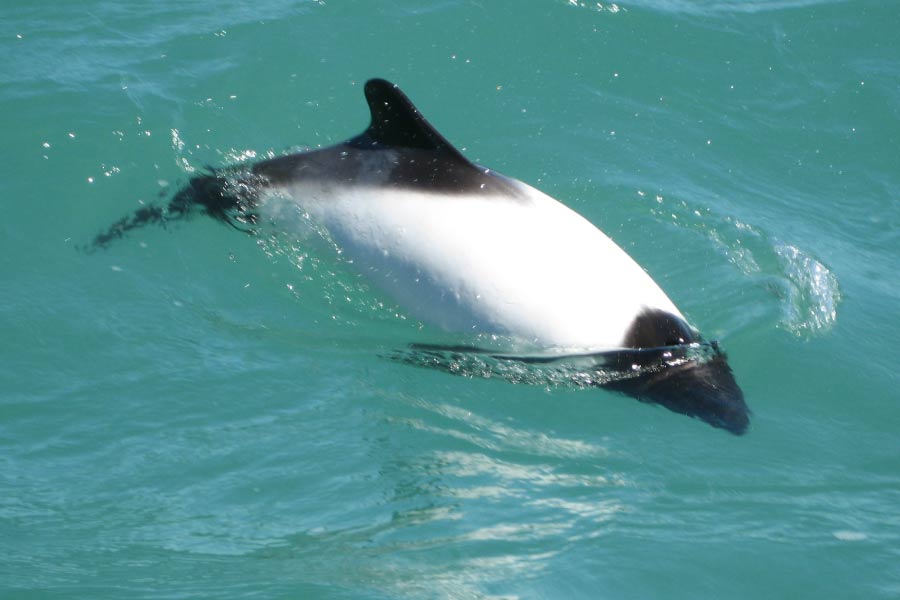
Scientific Name: Cephalorhynchus commersonii
Family: Delphinidae
Length: 1.5 to 2.5 meters (4.9 to 8.2 feet)
Weight: 35 to 85 kg (77 to 187 lbs)
Where found: Coastal waters of the southernmost parts of South America and around the Kerguelen Islands in the Indian Ocean
Conservation status: Least Concern
Commerson's Dolphins are known for their striking black and white patterning. One of the smallest dolphin species, they have a robust build and a rounded dorsal fin. They are energetic and acrobatic, often seen riding the bow wave created by boats. Their diet consists of fish and squid.
Commerson's Dolphin is named after French naturalist Philibert Commerson, who discovered the species as he circumnavigated the globe in an expedition led by admiral and explorer Louis Antoine de Bougainville.
Common Bottlenose Dolphin

Scientific Name: Tursiops truncatus
Family: Delphinidae
Length: Between 2 to 4 meters (6.6 to 13.1 feet)
Weight: Between 150 to 650 kg (330 to 1430 lbs)
Where found: Widely distributed around the world in both offshore and coastal areas, including harbors, bays, gulfs, and estuaries of temperate and tropical waters.
Conservation status: Least Concern
The common bottlenose dolphin is one of the most well-known dolphin species due to its use in aquarium shows and movies. The species is known both for its intelligence and its acrobatic behavior.
The common bottlenose dolphin is grey in color, with a lighter underside. It has a varied diet that includes fish and squid.
Common Dolphin

Scientific Name: Delphinus delphis
Family: Delphinidae
Length: 1.9 to 2.5 meters (6.2 to 8.2 feet)
Weight: 80 to 150 kg (176 to 330 lbs)
Where found: Warm and tropical seas worldwide
Conservation status: Least Concern
The common dolphin is the world’s most abundant cetacean, with a global population numbering several million.
Known for its playful behavior and agility, the common dolphin is popular with watchers of marine wildlife. It is a mid-sized species with a dark gray-black back, white belly and distinctive pale grey, yellow or gold hourglass-shaped patch on its sides.
Dusky Dolphin
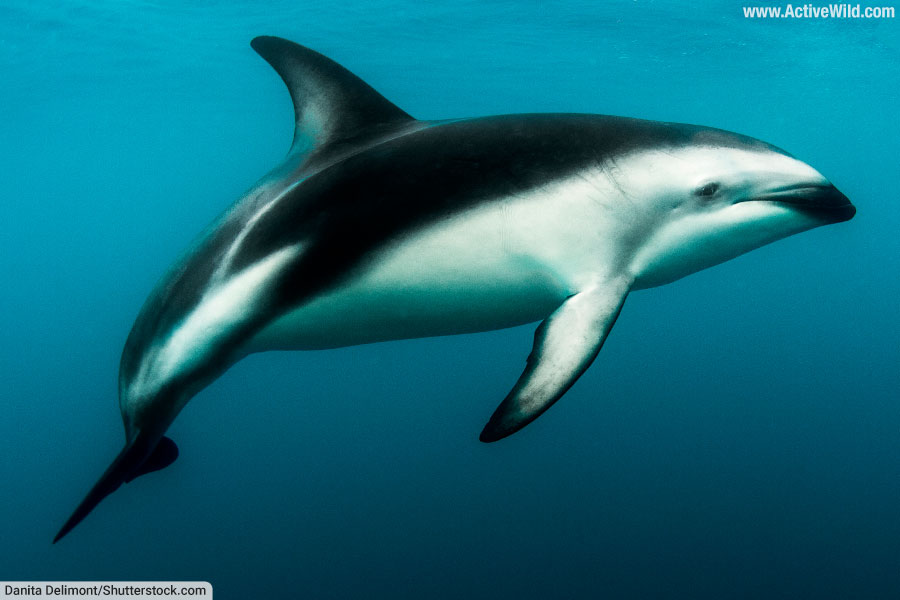
Scientific Name: Lagenorhynchus obscurus
Family: Delphinidae
Length: 1.7 to 2 meters (5.6 to 6.6 feet)
Weight: 70 to 85 kg (154 to 187 lbs)
Where found: Cool waters of the South Atlantic and South Pacific Oceans
Conservation status: Least Concern
The dusky dolphin is a small, robust cetacean known for its impressive acrobatics. It is easily identified by its short, curved dorsal fin and a complex, striking body pattern with a dark gray or black back, white underside, and characteristic light gray patch on the flank, extending from the tail to the center of the body.
Dusky dolphins inhabit cool, upwelling-rich waters of the Southern Hemisphere, particularly around South America, New Zealand, and some parts of Africa. They are primarily coastal but can also be found in offshore waters.
The dusky dolphin is known for its social nature and is often seen in large groups, sometimes numbering in the hundreds. The species’ acrobatic displays, including leaps, backslaps, and belly flops, are a spectacle to behold, making it a favorite among wildlife enthusiasts.
False Killer Whale

Scientific Name: Pseudorca crassidens
Family: Delphinidae
Length: 4.9 to 6 meters (16 to 20 feet)
Weight: 1,200 to 2,200 kg (2,600 to 4,900 lbs)
Where found: Found in tropical, subtropical, and temperate waters throughout the world
Conservation status: Near Threatened
The false killer whale, despite its name, is not directly related to the killer whale, or orca. The species is named for the similarity of its skull with that of the orca.
A large dolphin, the false killer whale typically measures up to 6 meters in length and can weigh as much as 1,500 kilograms. It is characterized by its elongated, slim body, rounded overhanging forehead, and small, conical, slightly upturned snout.
False killer whales are highly sociable and known for their playful behavior and occasional mass strandings. They are found throughout the world's tropical and temperate seas and have a preference for deep, open ocean environments.
False killer whales are known to share food among group members, highlighting their strong social bonds. The species has the IUCN conservation status 'Near Threatened' due to its low reproduction rates and threats such as bycatch, marine pollution, and reduction in prey from overfishing.
Fraser's Dolphin

Scientific Name: Lagenodelphis hosei
Family: Delphinidae
Length: 2.6 to 2.7 meters (8.5 to 8.9 feet)
Weight: 200 kg (440 lbs)
Where found: Deep waters of the Pacific and Indian Oceans
Conservation status: Least Concern
Fraser's dolphin is a lesser-known dolphin species known for its small beak, robust, torpedo-shaped body and a notably small dorsal fin relative to its body size. It has a striking color pattern, with a gray back and white undersides separated by a dark stripe that runs from the face, around the eye, and along the flanks.
Found in deep waters of the tropical Pacific and Atlantic Oceans, Fraser's dolphin is a highly social species, often traveling in large groups, sometimes numbering in the thousands. It is known to be a fast swimmer.
Guiana Dolphin
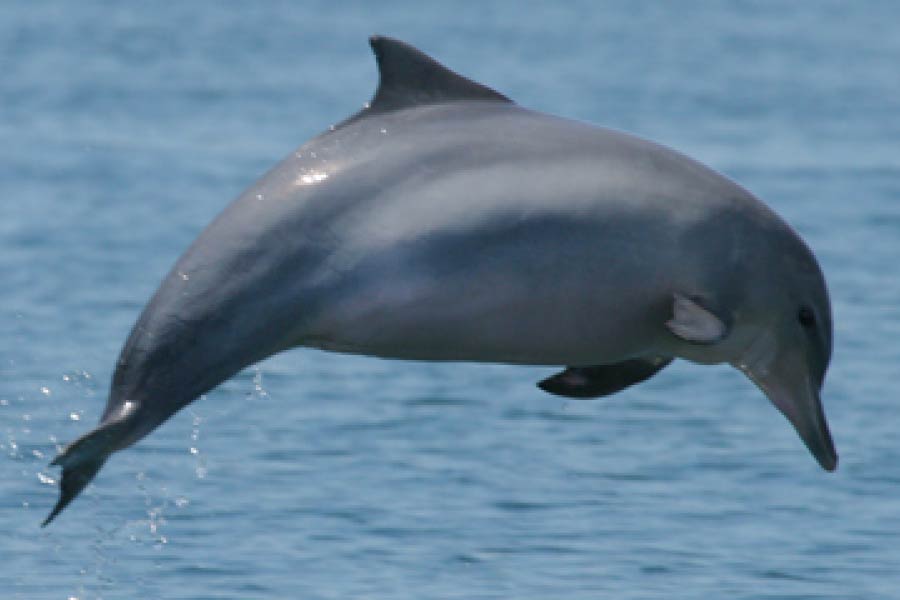
Scientific Name: Sotalia guianensis
Family: Delphinidae
Length: 1.7 to 2.2 meters (5.6 to 7.2 feet)
Weight: 40 to 60 kg (88 to 132 lbs)
Where found: Coastal areas and estuaries along eastern South America
Conservation status: Near Threatened
The Guiana dolphin, also known as the Costero or estuarine dolphin, looks like a small bottlenose dolphin, and has a robust build and prominent beak.
The species is found close to the Atlantic coast of South and Central America, and is known to venture into freshwater habitats. It is generally found in small groups of 2-10 individuals.
Guiana dolphins are known to herd fish onto the shore, momentarily stranding themselves in order to capture their prey.
Heaviside's Dolphin

Scientific Name: Cephalorhynchus heavisidii
Family: Delphinidae
Length: 1.7 to 2 meters (5.6 to 6.6 feet)
Weight: 75 to 80 kg (165 to 176 lbs)
Where found: Cold coastal waters off Namibia and the west coast of South Africa
Conservation status: Near Threatened
Heaviside's dolphin is a small, robust species with a dark grey top, lighter flanks, and a white belly. It is known for its acrobatic behavior and is often seen breaching and surfing in waves. Its diet consists mostly of fish and cephalopods.
Hector's Dolphin

Scientific Name: Cephalorhynchus hectori
Family: Delphinidae
Length: 1.2 to 1.6 meters (3.9 to 5.2 feet)
Weight: 40 to 60 kg (88 to 132 lbs)
Where found: Coastal waters of New Zealand
Conservation status: Endangered
Hector's dolphin is one of the smallest dolphin species in the world, and the only species found only in New Zealand. It has a unique rounded dorsal fin and has a pale grey body with dark head and fins.
This species is generally found in small groups and feeds on a variety of fish and squid.
Hourglass Dolphin

Scientific Name: Lagenorhynchus cruciger
Family: Delphinidae
Length: 1.8 to 1.9 meters (5.9 to 6.2 feet)
Weight: 90 to 120 kg (198 to 264 lbs)
Where found: Cold waters of the Southern Hemisphere, particularly around Antarctica
Conservation status: Least Concern
The hourglass dolphin is a relatively small species, named for the distinctive white, elongated "hourglass" pattern on its dark body. It has a short beak and a tall, curved dorsal fin
This dolphin inhabits the cold, sub-Antarctic waters of the Southern Hemisphere. It is usually seen in groups typically containing fewer than 10 individuals, but gatherings of up to 100 individuals are known.
While not much is known about the species’ behavior due to its remote habitat, it is known to be a fast swimmer and capable of spectacular aerial displays, often seen leaping and riding swells and waves.
Indian Ocean Humpback Dolphin
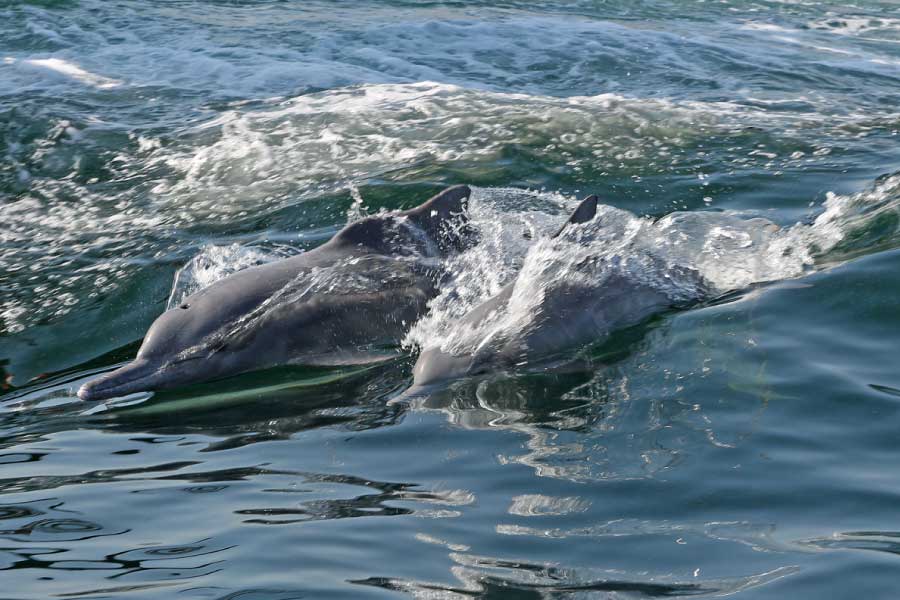
Scientific Name: Sousa plumbea
Family: Delphinidae
Length: 2.5 to 2.8 meters (8.2 to 9.2 feet)
Weight: 150 to 200 kg (330 to 440 lbs)
Where found: Coastal waters of the Indian Ocean from South Africa to India
Conservation status: Endangered
Like other humpback dolphins, the Indian Ocean humpback dolphin has a hump below the dorsal fin. It is generally grey to pink in color.
The Indian Ocean humpback dolphin is found along the coasts of the Indian Ocean, ranging from South Africa to India and as far east as the western borders of Thailand.
Indo-Pacific Bottlenose Dolphin

Scientific Name: Tursiops aduncus
Family: Delphinidae
Length: Between 2 to 2.6 meters (6.6 to 8.5 feet)
Weight: Between 150 to 230 kg (330 to 507 lbs)
Where found: Warm temperate to tropical Indian and Pacific Oceans
Conservation status: Near Threatened
The Indo-Pacific bottlenose dolphin is similar in appearance to the closely-related common bottlenose dolphin but generally smaller, with a relatively long snout and spots on its sides. It is dark grey, with paler undersides.
Known for its playful and curious nature, the Indo-Pacific bottlenose dolphin's diet primarily consists of fish and cephalopods.
Indo-Pacific Humpback Dolphin

Scientific Name: Sousa chinensis
Family: Delphinidae
Length: 2.5 to 2.8 meters (8.2 to 9.2 feet)
Weight: 150 to 200 kg (330 to 440 lbs)
Where found: Coastal waters from eastern India to southeastern China, the Philippines, and northern Australia
Conservation status: Vulnerable
Also known as the Chinese white dolphin, the Indo-Pacific humpback dolphin is found in shallow coastal waters in the Indo-Pacific region.
The species is characterized by a hump below the dorsal fin and a pale gray / white coloration, with some populations having a unique pink coloration.
Irrawaddy Dolphin

Scientific Name: Orcaella brevirostris
Family: Delphinidae
Length: 2.3 to 2.6 meters (7.5 to 8.5 feet)
Weight: 90 to 200 kg (198 to 440 lbs)
Where found: Shallow, near-shore tropical and subtropical marine waters of Southeast Asia, and in three large rivers: the Ayeyarwady in Myanmar, the Mahakam in Indonesian Borneo and the Mekong
Conservation status: Vulnerable
The Irrawaddy Dolphin has a rounded body with a high and rounded forehead, and lacks a beak. Its color is uniformly slate blue to slate gray. It is found in coastal areas, and will also enter freshwater habitats. Although sometimes called the Irrawaddy river dolphin, it belongs to the oceanic dolphin family, Delphinidae.
Killer Whale (Orca)
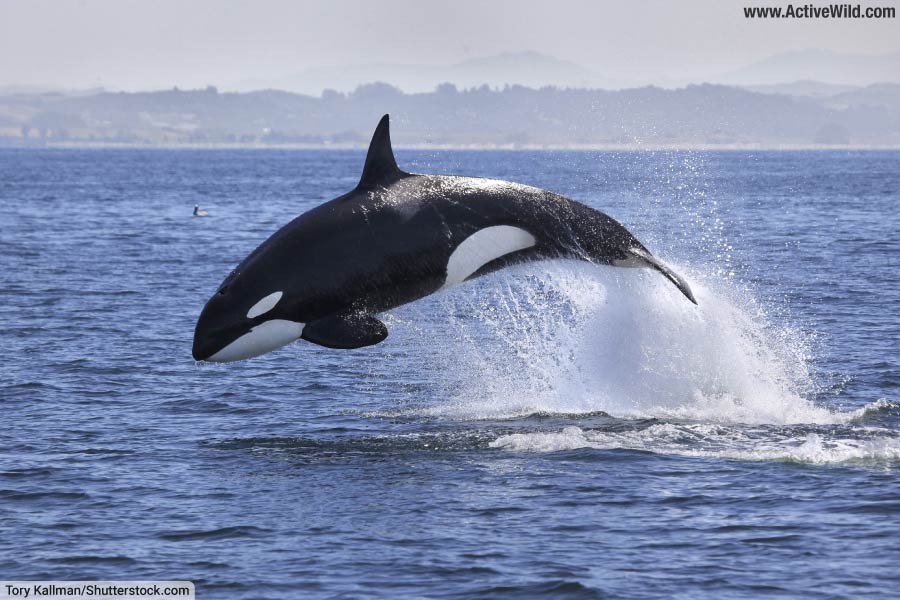
Scientific Name: Orcinus orca
Family: Delphinidae
Length: Up to 9.6 meters in males, up to 7 meters in females (31.5 feet in males, 23 feet in females)
Weight: Up to 6 tons in males, up to 4 tons in females (13,227 lbs in males, 8,818 lbs in females)
Where found: Distributed across global oceans, from Arctic and Antarctic regions to tropical seas
Conservation status: Data Deficient
Known for its distinctive black and white coloring, the killer whale, or orca, is the largest species of dolphin. It has a heavy and robust body and a large dorsal fin.
The killer whale is an apex predator with no predators of its own. It hunts fish and marine mammals. The species is highly social and often travels in family groups which can contain up to four generations.
Long-Finned Pilot Whale

Scientific Name: Globicephala melas
Family: Delphinidae
Length: 5.5 to 7.5 meters (18 to 25 feet)
Weight: 1,300 to 2,300 kg (2,866 to 5,070 lbs)
Where found: Both northern and southern hemispheres, in temperate and sub-polar areas
Conservation status: Least Concern
The long-finned pilot whale is a large dolphin species distinguished by its long, sickle-shaped pectoral fins and bulbous forehead. Its body is dark, usually black or very dark gray, with lighter patches on the throat and belly.
This species inhabits both open and coastal waters of the cooler regions of the Southern Hemisphere and the North Atlantic Ocean.
The long-finned pilot whale has been subject to mass strandings on beaches, the cause of which remains largely unknown. It also faces threats from hunting in some regions and incidental capture in fishing gear.
Melon-Headed Whale

Scientific Name: Peponocephala electra
Family: Delphinidae
Length: 2.5 to 2.75 meters (8.2 to 9.0 feet)
Weight: 200 to 300 kg (440 to 660 lbs)
Where found: Tropical oceans worldwide
Conservation status: Least Concern
Despite its name, the melon-headed whale is actually a dolphin. It has a somewhat conical, beak-less head (from which it gets its name) with a body that tapers to a narrow tail. It is typically dark gray with lighter undersides.
The melon-headed whale is highly social, forming pods that often contain several hundreds of individuals. The largest melon-headed whale pods contain up to 2,000 individuals.
Northern Right Whale Dolphin

Scientific Name: Lissodelphis borealis
Family: Delphinidae
Length: 2.1 to 3 meters (6.9 to 9.8 feet)
Weight: 100 to 150 kg (220 to 330 lbs)
Where found: North Pacific Ocean
Conservation status: Least Concern
The northern right whale dolphin is sleek and slender with a distinctive black and white pattern. It lacks a dorsal fin, which gives it a unique, smooth profile.
The species is often found in large groups. It is a fast swimmer that feeds on small fish and squid.
Pacific White-Sided Dolphin

Scientific Name: Lagenorhynchus obliquidens
Family: Delphinidae
Length: 1.9 to 2.5 meters (6.2 to 8.2 feet)
Weight: 150 to 200 kg (330 to 440 lbs)
Where found: North Pacific Ocean, from Japan to California
Conservation status: Least Concern
The Pacific white-sided dolphin has a dark gray body with a white underside and distinctive gray stripes on the sides. Its snout is short and its dorsal fin tall and hooked.
It lives in groups containing 10 to 100 individuals, and is known to take care of sick or injured members of its group.
Pantropical Spotted Dolphin

Scientific Name: Stenella attenuata
Family: Delphinidae
Length: 1.8 to 2.7 meters (5.9 to 8.9 feet)
Weight: 80 to 130 kg (176 to 286 lbs)
Where found: Warm waters of the Atlantic, Pacific, and Indian Oceans
Conservation status: Least Concern
Pantropical spotted dolphins have a slender body with a distinct dark dorsal cape, spots covering their light gray or white sides, and a dark eye ring. They are highly social and often seen leaping and riding the bow waves of boats.
The pantropical spotted dolphin is one of the world’s most abundant dolphin species.
Peale's Dolphin
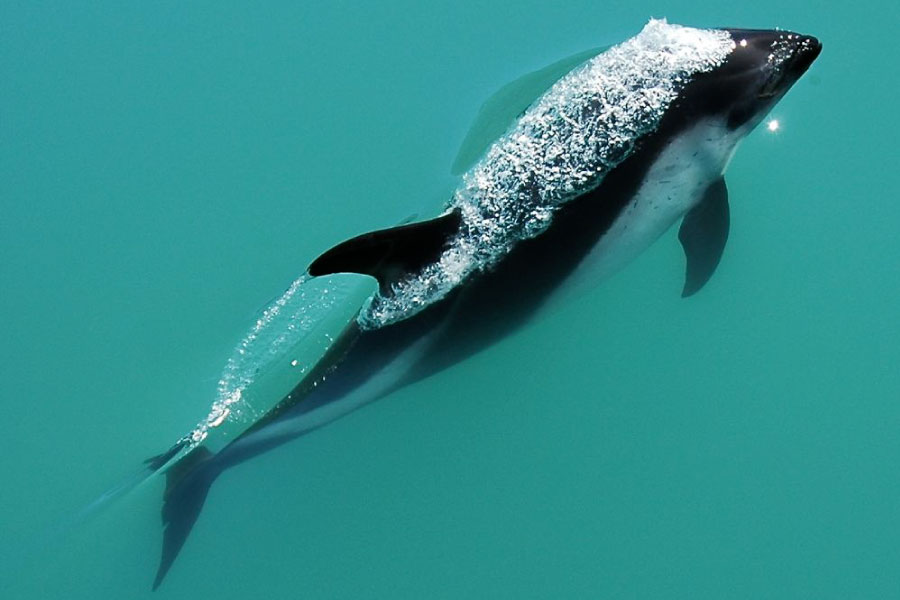
Scientific Name: Lagenorhynchus australis
Family: Delphinidae
Length: 2.1 to 2.5 meters (6.9 to 8.2 feet)
Weight: 115 to 130 kg (253 to 286 lbs)
Where found: Waters around the Falkland Islands and the southern tip of South America
Conservation status: Least Concern
Peale's dolphin has a robust body, a short beak, and is dark gray to black in color, with white patches around its flippers and on its tail. It is also known as the black-chinned dolphin.
Peale's dolphin lives in small pods and is occasionally seen with other dolphins, including Commerson's dolphin.
Pygmy Killer Whale

Scientific Name: Feresa attenuata
Family: Delphinidae
Length: 2.1 to 2.6 meters (6.9 to 8.5 feet)
Weight: 110 to 170 kg (243 to 375 lbs)
Where found: Tropical and subtropical oceans worldwide
Conservation status: Least Concern
The pygmy killer whale is a small, dark dolphin with a rounded head and no beak. It has a falcate (hooked or curved like a sickle) dorsal fin and long, pointed flippers. Despite its name, it is not closely related to the killer whale.
Risso's Dolphin
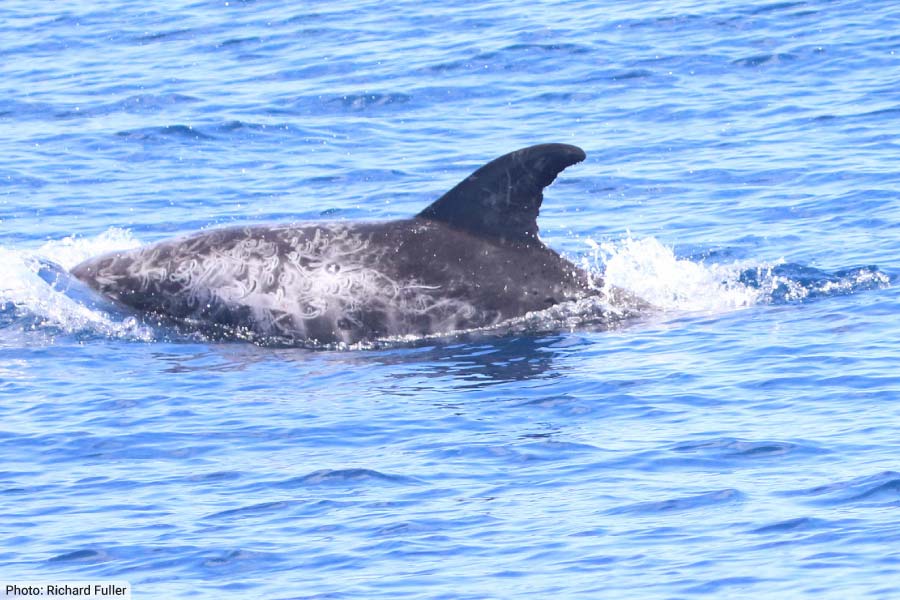
Scientific Name: Grampus griseus
Family: Delphinidae
Length: 2.6 to 4 meters (8.5 to 13.1 feet)
Weight: 300 to 500 kg (661 to 1,102 lbs)
Where found: Temperate and tropical oceans worldwide
Conservation status: Least Concern
Risso's Dolphins have a robust body with a unique creased forehead, a tall dorsal fin, and a dark gray body covered in extensive white scarring. They feed almost exclusively on squid and are known for their deep diving abilities.
Rough-Toothed Dolphin

Scientific Name: Steno bredanensis
Family: Delphinidae
Length: 2.1 to 2.9 meters (6.9 to 9.5 feet)
Weight: 100 to 150 kg (220 to 330 lbs)
Where found: Tropical and subtropical oceans worldwide
Conservation status: Least Concern
Rough-toothed Dolphins are named for the distinctive ridges on their teeth. They have a slim body, a long beak, a tall dorsal fin, and a dark gray color with lighter patches. They are typically found in deep offshore waters and feed on fish and squid.
Short-Finned Pilot Whale

Scientific Name: Globicephala macrorhynchus
Family: Delphinidae
Length: 3.6 to 6.7 meters (12 to 22 feet)
Weight: 1,000 to 3,000 kg (2,204 to 6,613 lbs)
Where found: Tropical and temperate oceans worldwide
Conservation status: Least Concern
Similar to the long-finned pilot whale but with shorter fins, shorter beak and fewer teeth, the short-finned pilot whale has a round forehead, bulbous melon, and a dark gray to black body.
Like its long-finned cousin, the short-finned pilot whale is prone to mass stranding events.
Southern Right Whale Dolphin
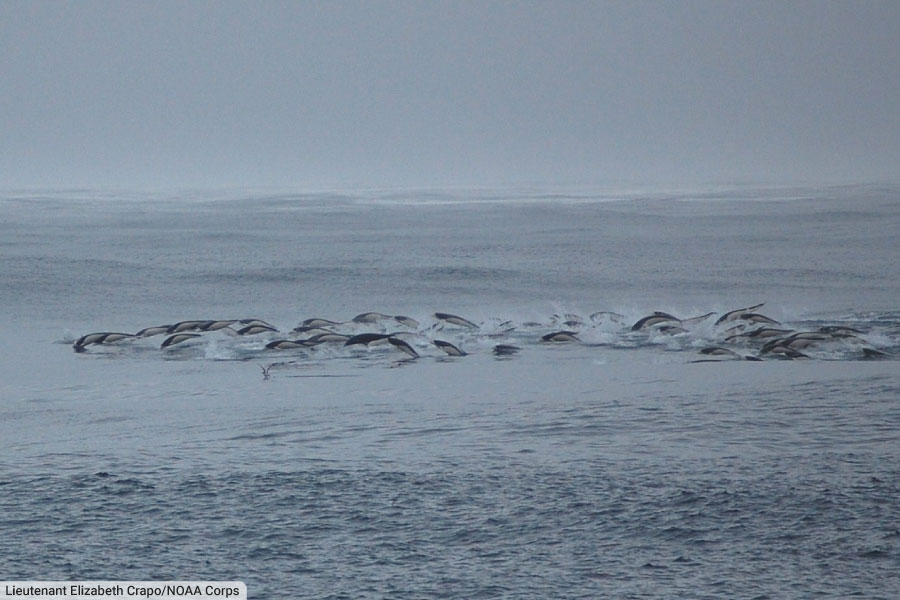
Scientific Name: Lissodelphis peronii
Family: Delphinidae
Length: 2.2 to 3 meters (7.2 to 9.8 feet)
Weight: 100 to 150 kg (220 to 330 lbs)
Where found: Cold waters of the Southern Hemisphere
Conservation status: Least Concern
Similar in appearance to its northern counterpart, the southern right whale dolphin has a streamlined body, a small fluke, and lacks a dorsal fin. It is generally black with a white belly and throat, and is known to be a very active and fast swimmer.
Spinner Dolphin
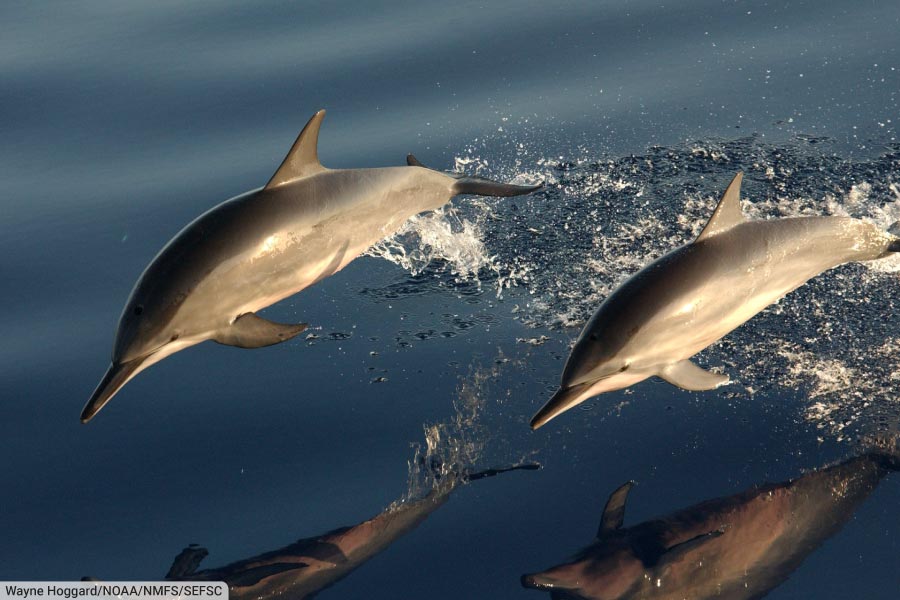
Scientific Name: Stenella longirostris
Family: Delphinidae
Length: 1.2 to 2.3 meters (3.9 to 7.5 feet)
Weight: 55 to 75 kg (121 to 165 lbs)
Where found: Tropical oceans worldwide
Conservation status: Least Concern
Spinner Dolphins are known for their acrobatic displays, often leaping and spinning out of the water. This behavior may be a form of communication, or a means to remove parasites (or both). They have slim bodies, a long thin beak, and most have a distinctive tri-color pattern with a dark gray dorsal area, a light gray middle, and white or light gray undersides.
You can find out more about the spinner dolphin on this page: Spinner Dolphin Facts
Striped Dolphin

Scientific Name: Stenella coeruleoalba
Family: Delphinidae
Length: 1.8 to 2.6 meters (5.9 to 8.5 feet)
Weight: 100 to 140 kg (220 to 308 lbs)
Where found: Tropical and warm temperate waters worldwide
Conservation status: Least Concern
Striped dolphins have a slender, streamlined body with a prominent beak and a dark bluish-gray color on their back, light gray on their sides, and a characteristic blue and white striped pattern along their flanks. The species lives in large groups that may contain thousands of individuals.
Tucuxi

Scientific Name: Sotalia fluviatilis
Family: Delphinidae
Length: 1.5 to 1.8 meters (4.9 to 5.9 feet)
Weight: 40 to 60 kg (88 to 132 lbs)
Where found: Coastal waters, estuaries, and rivers of the Amazon and Orinoco basins in South America
Conservation status: Endangered
The tucuxi is a small dolphin with a stocky body, a rounded head, and a prominent beak. It is dark gray to black in color with lighter undersides.
Despite being a member of the oceanic dolphin family, the tucuxi is only found in freshwater habitats. It inhabits the Amazon River Basin in South America.
The tucuxi is occasionally observed with the Amazon river dolphin, but the two species are unrelated.
White-Beaked Dolphin

Scientific Name: Lagenorhynchus albirostris
Family: Delphinidae
Length: 3.3 meters (10.8 feet)
Weight: 200 to 350 kg (440 to 770 lbs)
Where found: Cold-temperate waters of the North Atlantic Ocean, including the coasts of Iceland, Greenland, and parts of Europe
Conservation status: Least Concern
As its name suggests, the white-beaked dolphin typically has a white beak, although this is less noticeable in some individuals. It is found in cold northerly waters.
Amazon River Dolphin
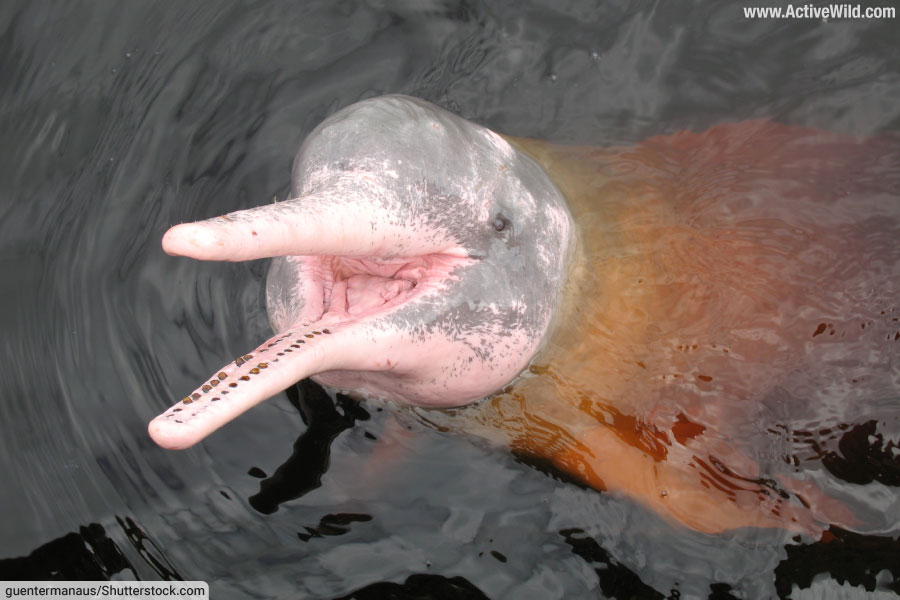
Scientific Name: Inia geoffrensis
Family: Iniidae
Length: 1.5 to 2.5 meters (4.9 to 8.2 feet)
Weight: 85 to 160 kg (187 to 352 lbs)
Where found: Amazon River and its tributaries in South America
Conservation status: Endangered
The Amazon River dolphin, also known as the pink river dolphin or boto, has a unique appearance, with some individuals having an almost entirely pink-gray color.
The species’ neck vertebrae are unfused, allowing it to turn its head 90 degrees. This adaptation allows the dolphin to turn in tight circles, helping it to maneuver through flooded forests.
Baiji

Scientific Name: Lipotes vexillifer
Family: Lipotidae
Length: Up to 2.5 meters (8.2 feet)
Weight: 110 to 170 kg (243 to 375 lbs)
Where found: Yangtze River in China
Conservation status: Critically Endangered (Possibly Extinct)
The baiji, also known as the Yangtze River Dolphin, was a freshwater dolphin found in China’s Yangtze river system.
No confirmed sightings of the baiji have been made since 2002, and it is likely that the species is now extinct.
The baiji had a distinctive long, narrow beak and was light gray to bluish in color. Its vision was poor, and it relied on echolocation to navigate the murky waters of the Yangtze.
Franciscana
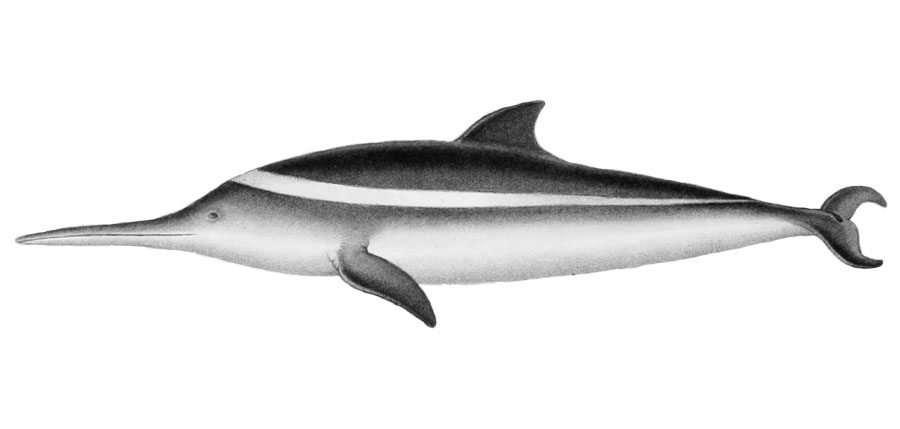
Scientific Name: Pontoporia blainvillei
Family: Pontoporiidae
Length: 1.4 to 1.7 meters (4.6 to 5.6 feet)
Weight: Up to 50 to 55 kg (110 to 121 lbs)
Where found: Coastal waters of the southwestern Atlantic Ocean, particularly around Argentina, Brazil, and Uruguay
Conservation status: Vulnerable
The franciscana, also known as La Plata dolphin, has a slender body, a rounded head, and a long beak. It has a grayish back, fading to a lighter shade on the sides and belly. Although a river dolphin, it is typically found close to the shore in coastal waters, or in estuaries.
South Asian River Dolphin(s)
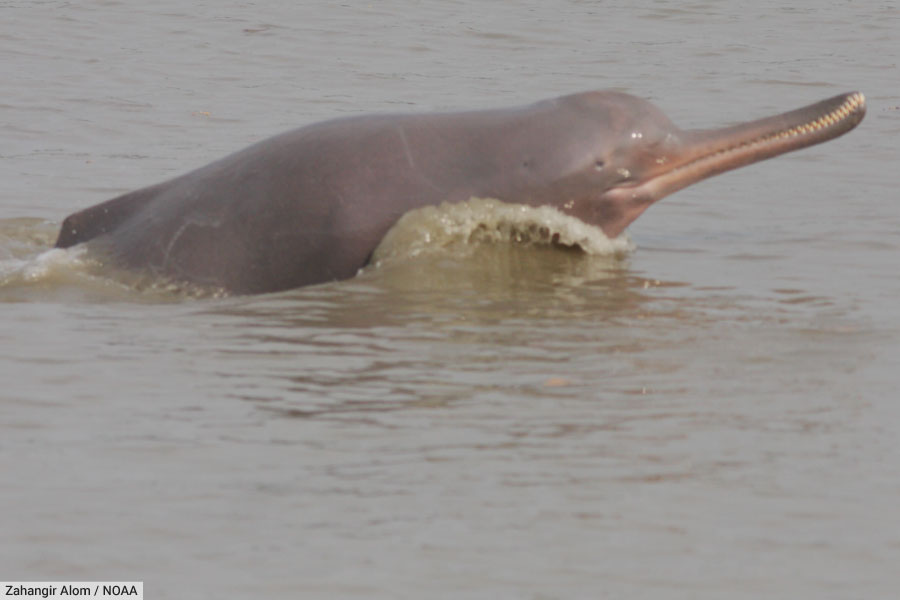
Scientific Name: Platanista gangetica
Family: Platanistidae
Length: 2 to 2.5 meters (6.6 to 8.2 feet)
Weight: 70 to 90 kg (154 to 198 lbs)
Where found: Rivers of the Indian subcontinent, including the Ganges, Brahmaputra, and Indus River systems
Conservation status: Endangered
The South Asian river dolphin has a long, slender body and a long beak with sharp teeth. It is grayish-brown in color with a lighter underside.
Having evolved in murky river water, the South Asian river dolphin has no use for acute eyesight. As a result, its eyes are undeveloped and it is virtually blind. It navigates and hunts instead using its highly-developed sonar system.
Research carried out in 2021 suggests that the Ganges river dolphin and the Indus river dolphin, previously believed to be subspecies of the South Asian river dolphin, are separate species.
Many authorities now recognize this change, with the Ganges river dolphin taking the scientific name Platanista gangetica, and the Indus river dolphin having the scientific name Platanista minor. Both of the newly-recognized species are endangered.
How We Compiled This List Of Dolphin Species
List last updated 29/06/2023
In compiling this list, we consulted the Catalogue of Life, and Mammal Species of the World – both of which are well-regarded online species databases.
In the case of species that are included in one, but not the other, of the above databases, we attempted to use the most up to date information available to compile a list that represents the current understanding of cetacean classification.
Differences in lists of this type are generally caused by very closely-related species, which some authorities regard as being separate species, but others regard as being subspecies of a single species.
Mammal Species of the World (MSOTW) recognizes two species of South Asian river dolphins (Ganges River Dolphin and Indus River Dolphin), whereas the Catalogue of Life (COL) currently views these as subspecies rather than separate species.
MSOTW also recognizes the Long-beaked Common Dolphin, which other authorities (including the COL) now combine with the common dolphin.
The dolphin species listed in the Catalogue of Life which aren’t listed in Mammal species of the world are the Australian Snubfin Dolphin, South Asian River Dolphin (which, as discussed above, is now considered to be two separate species), Guiana Dolphin, Indian Ocean Humpback Dolphin and Australian Humpback Dolphin. All of these species have been included on this page.


